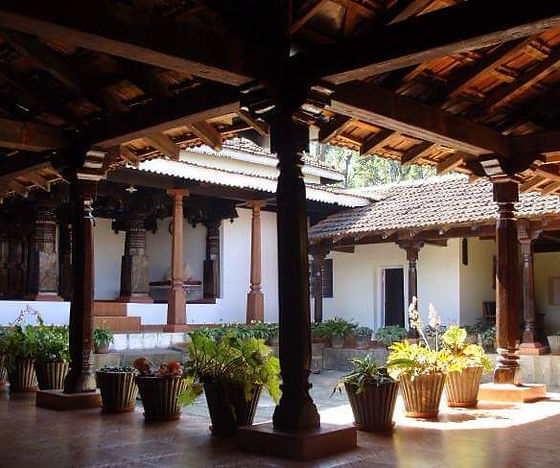
According to the Cambridge dictionary the word ‘Architecture’ stands for ‘the art and science of designing and making buildings or the style of a building’. These designs of the buildings depend on some factors. In those factors, region is the most important one, along with region socio-economic factors and climates come together. A term vernacular architecture is also present here which is related to the traditional structure of a region. There are multiple vernacular architectures that have developed multiple times in different regions which are related to the socio-economical and political conditions of the period and here the influence from different parts of the world has played a key role in developing the design and style of the buildings. To develop the style and design of the architecture people used different kinds of materials whereas, vernacular architectures were dependent on indigenous elements like water, light, and ventilation which also are the cooling factors in the hot and humid climate. By using these vernacular elements, several structures have evolved and modified with converting water bodies in the form of pools, canals, and fountains in the courtyards to help reduce the impact of the hot and dry climate.
Courtyards are the most important part of Indian houses. These courtyards have a significant role in mitigating the hot temperature by channelizing the breeze to adjust the humidity apart from these, They also act as a cool air-reserver specifically in the hot-arid climate area. The courtyards are not only found in vernacular architecture but also present in all architecture apart from the modern flat structure, from the northern to the southern part of India. In different regions, houses with courtyards are known by different names, like Haveli in north and north-west India; Wada, the residential architecture in Maharashtra; Nalukettu in Kerala; Chettinad, a typical residential house of Chettiar Brahmins in Tamil Nadu and Rajbari In Bengal and others.
This article will focus on the Chettinad style houses which are historically significant along with their climatic and eco-friendly aspect. Chettinad is in the southeast part of India in the state of Tamil Nadu. The different sources, especially, folklore, legends, mouth of the stories claim the Nattukkottai Chettiars community migrated to the current location from the coastal region of Tamil Nadu in hundred years ago but how they settled in the current location, this exact reason is still unknown due to the lack of proper evidence. These houses are made by the Nattukkottai Chettiars community who were involved in trade. Their business was widespread in South Asian countries like Burma, Malaysia and Singapore which lived under the flags of the Dutch and British. Due to the travel, they were influenced by the beautiful characteristics of Burmese and European styles which they blended into their architecture and constructed Chettinad Style Houses. They balanced Western and traditional architecture in the Chettinad style houses. The exterior of the architecture, followed palatial European architecture whereas the interior part of the houses was built in a traditional way. To build the interior part of the houses which are traditional in structure, they used indigenous and local elements that are described in detail in the following paragraphs with the climatic aspect.
Courtyards:
The symmetrical layout of the courtyards with athangudi tiles of Chettinad style houses represents the rich heritage of Dravidian architecture of the region. These spacious courtyards help to provide natural ventilation in the tropical region like Tamil Nadu. These houses with inner courtyards are designed with climate consciousness by arranging the rooms all around the central opening. The centre and open courtyards help to form a microclimate which provides comfort in hot temperatures by regulating inner temperature via the wind stack effect. Heated air escapes out due to the presence of it and the cooler air from the bottom level and then passes through the back and front doors which are present in the same passage as the courtyard.

Open space courtyards
(Source: Kali)
Athangudi Tiles:
Athangudi tiles are a significant element which is used in Chettinad style houses which helps to defeat the hot climate by not reflecting or not radiating the heat. These terracotta tiles keep the rooms cooler than other tiles due to their thickness. Athangudi tiles are made of cement, sand and baby jelly by using an interesting process to prepare it and it also takes a long time to make. Any special machines or anything is not required to make the tiles, it is completely handmade. These athangudi tiles are heavy enough and the thickness of the tiles is three to four inches and the age of the tiles is too long without any repairing. These tiles are not only suitable for hot and humid climates but they are also natural and eco-friendly.
Wall Construction and Plaster:
The wall construction is also an essential cooling factor for any architecture. In Chettinad architecture, the walls are quite thick. To reduce the heat and control the temperature, they make the inner wall 16’’ whereas the outer wall is 1 ¾’ to 2’ and it is also used as storage space. Normally, these walls are constructed with country burnt bricks.
To maintain the cool interior of the house in the hot humid summer, they evolved a unique wall plaster method in the chettinad architecture which is also known as ‘Chettinadu plaster’. These walls are coated with different layers of the mixture of ground white seashells, lime base liquid egg white, and karupatti ( traditional sugar jaggery) to make it. Vegetable dyes, which are made from waste vegetables, are used to paint the pictures. The wideness of the walls which are 1.5 ft to 3 ft helps to keep the room cool without using any electronic materials.
Roof:
Generally, it follows the Madras terrace concept to make the roof. The courtyard roof was built by using the Machu concept where below the roofing, the loft is present there with a height of 3’ to 4 ’, and it is also used as a store and under this are the wooden beams which run through. This roofing structure helps to reduce the heat by stopping the heat transfer in the building.
These house structures are constructed in three phases and the materials are also changed in every phase. The walls are based on the hard stones which are called Karungkal and the soil which is filled up to 4 ft of the height and leaves for three years in the rain and sun to set the soil. These local materials respond to the local environment and climate effectively and make the environment suitable for human beings.
To maintain the temperature inside the houses, the Chettinad architecture has followed several vernacular and traditional elements and features. By using these techniques the structure does not need an artificial cooling system in the arid hinterland to protect from the heat and humidity.
REFERENCE
Sarkar, K.D., 2015. Indian vernacular planning. Civil engineering and urban planning: An International Journal, 2(1), pp.37-48. Available from: https://d1wqtxts1xzle7.cloudfront.net/37239523/2115civej04-libre.pdf?1428469880=&response-content-disposition=inline%3B+filename%3DINDIAN_VERNACULAR_PLANNING.pdf&Expires=1718004487&Signature=K860G8DQJjBfUa4mUdvThJgp0FK4s2GKTO~dk0LZby~whXcfTP3IB38W6SCJKS~BDB3VlslYbv~cpQvNwEDzkY0bIRuQOMmmADztYTtkX-MxOs6QF5u8gmSFY7-ad5sRCKl3V-ISRi2rf9dn8NG-VWhW-Vu0IkSV5bhMWbv38fIO0HNQBlcolX3Dpd8nbLBxypBO6DDUL1toiDyS7W3BnCc4JubxAm3p8v1z1uFjziX4SjuXi54yPEbNMP3cNsD2ZOS5rdKc0AtRBvRfVxJr-ximHpux6JRGDwOJdkfBz6RRWTvlkxVzb1Ny81OGxhfJB56KfO4D6I-4cKr5VNkdEA__&Key-Pair-Id=APKAJLOHF5GGSLRBV4ZA. [Accessed 4 June 2024]
Sthapak, S. and Bandyopadhyay, A., 2014. Courtyard houses: An overview. Recent Research in Science and Technology, 6(1). Available from: https://core.ac.uk/download/pdf/236010927.pdf. [Accessed 4 June 2024]
Ranka, K.R., 2023. Reviving urban courtyards: investigating the socio-cultural potential of greenery and productive landscapes for community resilience in Milan. Available from: file:///C:/Users/USER/Downloads/2023_12_Ranka.pdf. [Accessed 4 June 2024]
Kali. 2023. Role of Courtyards in Chettinad House Designs. Kali Natural Building Initiative. Available from: https://www.kali-natural-buildings.com/role-of-courtyards-in-chettinad. [Accessed 4 June 2024]
Radhakrishnan, S. and Priya, R.S., 2014. Eco friendly materials used in traditional buildings of Chettinadu in Tamil Nadu, India. American Journal of Sustainable Cities and Society, 1(3), pp.335-344. Available from: https://citeseerx.ist.psu.edu/document?repid=rep1&type=pdf&doi=d90c04a4f8cee59a10f4d1f22b97bd79d3c0f73f. [Accessed 4 June 2024]
Patwardhan, A. and VIT’s, P.V.P., ATINER’s Conference Paper Series ARC2017-2393. Available from: https://www.atiner.gr/papers/ARC2017-2393.pdf. [Accessed 4 June 2024]
- Chettinad architecture design
- Chettinad heritage homes
- Chettinad style roof
- Chettinad traditional design
- Chettinadu architectural elements
- Courtyard architecture Chettinad
- Hot climate architecture South India
- Southern India climate-friendly architecture
- Sustainable design Chettinad houses
- Traditional Tamil Nadu architecture



















